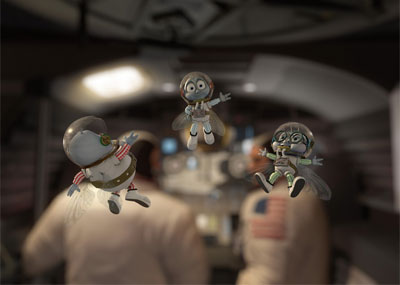Fly Me To The Moon: it could be worseby Taylor Dinerman
|
| What is significant about this movie, and makes it a important part of the ongoing debate about the value of human spaceflight and the ongoing effort to get back to the Moon before 2020, is that it exists at all. |
The animation is disappointing: with all the technology and the skilled technicians and artists available they should have done better. The cute little insects are state of the art, but the humans are either waxworks versions of well-known characters such as Amelia Earhart and the famous trio of Aldrin, Armstrong, and Collins, or awkward stock figures. The filmmakers obviously went to a lot of trouble to get the cultural artifacts such as the cars and television sets from 1969 just right; too bad they failed to humanize the humans.
The story of how Nate and his friends smuggle themselves onto the capsule and ride along and the way their families react to the news is not without a certain charm. The subplot about a Soviet insect plot to sabotage the mission and how it is undone by Nate’s grandpa and his old Russian girlfriend is enough to warm an old Cold Warrior’s heart. It is, after all, a children’s movie, so the holes in the plot—big enough to fly a rocket through—can be safely ignored.
There is also no reason to complain about all the technical mistakes. The Saturn 5 seems to reach orbit without dropping off any stages. In the movie the astronauts reach lunar orbit before attaching the LEM to the Command Module. The kids will just have to “unlearn” this stuff when they grow up: not a big deal, since they already have a lot of that to do anyway.
What is significant about this movie, and makes it a important part of the ongoing debate about the value of human spaceflight and the ongoing effort to get back to the Moon before 2020 (about the time the target audience for this film will be entering college), is that it exists at all. Someone in the film industry thought that the story of first Moon mission was attractive enough to children and their parents to invest real money into making this thing. At a time when fantasy, such as the Narnia movies, are capturing the public imagination and their dollars, the fact that a film about the very unfanciful Apollo program can be made at all is important.
What other event from 1969 can inspire children? Nixon’s leadership? The sex, drugs, and rock and roll at Woodstock? Not much, but the first human steps on the Moon is something that is fixed in America’s collective memory. Passing on that story to future generations seems to come naturally to the men and women who run the entertainment industry.
This shows that there is a deep and ongoing fascination with human spaceflight. Today’s NASA missions are not covered with the same breathless wonder that existed in 1969. No person has left low Earth orbit (LEO) since 1972. When it does happen again it will, one hopes, reignite some of the sense of wonder and awe that existed in that era. It will not be done for the same reasons. The Cold War is over and real, as opposed to symbolic conflicts in space may occur well before 2020.
| The people who made this movie must, at some level, “Get It!” They understand that our species, which can create these highly sophisticated animated insects, has the need and the ability to create new homes and new environments for itself. |
By then the needs of the Earth’s population for energy and for other resources will be the driving force. The Moon may be the best place to build the principal mass of future solar power satellites. It is also going to prove an important place for large-scale Earth observation systems. By 2030 it may no longer be a focus of exploration activities but a place to do science and commerce.
The people who made this movie must, at some level, “Get It!” They understand that our species, which can create these highly sophisticated animated insects, has the need and the ability to create new homes and new environments for itself. Some of the kids who see this movie will also “Get It” and they will be the ones who will be out there, beyond LEO, actually building the real spacefaring civilization.
